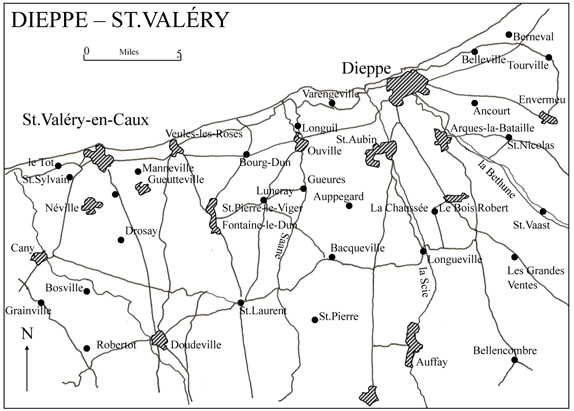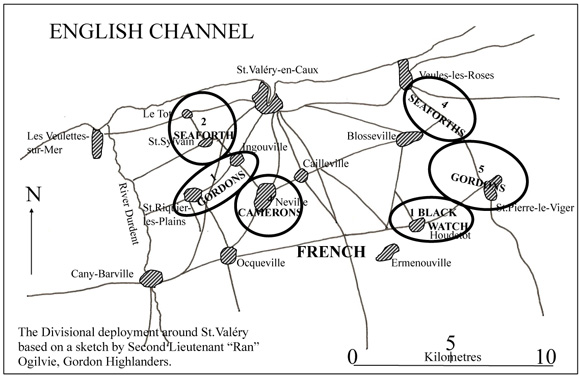Surrender at St. Valéry
June 1940

Map of Dieppe - St. Valery
show infoDescription:
Sketch map of Dieppe - St. Valery-en-caux
High Resolution Image:
Tags:
Within a few hours of the dispatch of Ark Force, reports early on the morning of 10th June of the German advance made it apparent that the remainder of the Division was being cut off and the opportunity to evacuate through Le Havre was increasingly unlikely. General Fortune therefore decided to evacuate through St.Valéry-en-Caux. This news reached the Navy at 0400 hours on 10th June and preparation began.
St.Valéry-en-Caux was a small and far from ideal port for such an operation but there was no alterative.
A box was drawn around the town with the 2nd Seaforths, 1st Gordons and 4th Camerons on the west side and 4th Seaforths, 5th Gordons and 1st Black Watch on the east side. The French were due to take up the bottom or south side of the box but until they arrived the Lothian's, Norfolk's and the 6th Battalion, Royal Scots Fusiliers (Pioneers) would cover the gap. The Division was in position early on the 11th June but the perimeter was never fully established.
The Germans, moving at great speed, were discovered by the Lothian and Border Horse in strength at Cany, to the west. The Germans pressed the line from the west along the coast and the south west. In the east the 4th Seaforths, 5th Gordons and 1st Black Watch were all in action.

Map of divisional deployment around St. Valery
show infoDescription:
Sketch map of Divisional deployment around St. Valery. Based on a sketch by Second Lieutenant "Ran" Ogilvie of Gordon Highlanders.
High Resolution Image:
Tags:
General Fortune issued the following directive to commanding officers at 1000hrs on the 11th June:
"The Navy will probably make an effort to take us off by boat, perhaps to-night, perhaps in two nights. I wish all ranks to realise that this can only be achieved by the full co-operation of everyone. Men may have to walk five or six miles. The utmost discipline must prevail.
"Men will board the boats with equipment and carrying arms. Vehicles will be rendered useless without giving away what is being done. Carriers should be retained as the final rearguard. Routes back to the nearest highway should be reconnoitred and officers detailed as guides. Finally, if the enemy should attack before the whole force is evacuated, all ranks must realise that it is up to them to defeat them. He may attack with tanks, and we have quite a number of anti-tank guns behind. If the infantry can stop the enemy's infantry, that is all that is required, while anti-tank guns and rifles inflict casualties on armoured fighting vehicles."
During the afternoon of the 11th June the 1st Black Watch at St. Pierre-le-Viger came under great pressure from the Germans and by 1800hrs had lost some 50 men wounded or dead. They were supported by French cavalry who dismounted and, leaving their horse in a wood, fought as infantry. The position was finally overrun at dawn.
To the west the perimeter was penetrated and the 2nd Seaforths cut off in Le Tot. Without their anti tank platoon, which was on the other side of St Valéry, the enemy tanks were able to bypass them but not without loss. There were many fires in the town which was under constant bombardment from artillery and air attack. In the town the Divisional HQ, the 51st Anti-Tank regiment, part of the Norfolks and a Company of Kensingtons secured the perimeter. An attack into the town was repulsed in the late afternoon but the town was now surrounded. Final plans were now made for the evacuation, beaches allotted and orders given but these did not reach the 2nd Seaforths cut off in Le Tot.
After arriving in the harbour on the 10th and finding no one there the Navy had withdrawn on the 11th and after coming under air attack pulled further out to sea. When the order came to carry out the evacuation it was too late. A combination of fog obscuring the coast, the loss of several boats and the fact that the enemy occupied the cliffs overlooking the town made evacuation impossible.
Various local demands for surrender, specifically to 2ndSeaforths and 1st Gordons were robustly rebuffed. Preparations were made for a last resistance. Meanwhile the French capitulated at 0800hrs on the morning of the 12th June.
General Fortune considered all the options, a counter attack, further resistance, retaking the town but against this there was no possibility of evacuation or support, the men were exhausted and virtually out of ammunition, with no artillery ammunition at all. Shortly before 1000hrs on the 12th June General fortune took the most difficult of decisions - to surrender.
Report from C. in C. Portsmouth describing Naval efforts made to evacuate the 51st Highland Division between 10th - 12th June 1940.
A transcription of Major Grant's diary covering the period from the 9th to 12th June 1940. Includes excellent sketch maps and an account of the Division's movements.
An extract from “Escape from Saint Valery-en-Caux - Recounting the Adventures of Captain B C Bradford”. This section describes the retreat towards St. Valery on the 11th/12th June 1940.
A personal account from Tom Wardle Garside RASC of his lucky escape along the beach at St. Valery on the night of the 11th June 1940, eventually reaching the 'Sir Evelyn Wood', a tramp steamer awaiting off-shore.
A description of the action around St. Valery in June 1940, compiled from personal accounts by Cmdr. Meyrick, Lt. Cmdr. Howse, Mr.F.G. Bull, and A. Hales from HMS Boadicea, and from HMS Bulldog, Cmdr. Hewitt, and Lt. Cmdr. Bryden
An extract from the War Diary of Capt. J.P.P. Taylor, the Intelligence Officer of the 1st Battalion, Gordon Highlands, describing in detail the movement of the Bn in the hours leading up to the surrender at St. Valery, 11th/12th June 1940
Two accounts of ‘D’ Coy 7th Royal Norfolk and their capture at St. Valery June 11th & 12th 1940
An extract from the War Diary of Captain R.A.A.S. Macrae, then Adjutant to 4th Battalion Seaforth Highlanders, covering the period 11/12th June 1940.
Copy of a Letter received by Sgt (AC) G.C.Claridge, from Bdr (AC) W.H Prandle 101st L.A.A. & A.Tk.Regt.R.A. (old 5th Bn R.W.F.,TA), Dated 15th July 1940. This letter has been Provided by a contact in the Royal Welch Fusiliers Museum and provides a fascinating account of the retreat to St. Valéry by one of the lucky ones that got away.

Major General Fortune with General Major Rommel
show infoDescription:
Major General V M Fortune, GOC [General Commanding Officer] 51st Highland Division (right), with General Major Erwin Rommel at St. Valéry after the surrender of the 51st Division to Rommel's 7th Panzer Division (12th June 1940)
Copyright:
IWM RML 342
Tags:
An extract from the diary of Major Mackintoush Walker, detailing his escape after St. Valery with Major Tom Rennie. Runs 21 Jun - 4 Aug.
An extract from the journal of George Clare, 525 Company, Royal Army Service Corps. The later part of this extract concerns the days running up to the surrender on the beach at St. Valéry.
An account from Edward G. Rankmore, A Company, 2nd Battalion of the Seaforth Highlanders, written whilst a POW, of his attempt to get away from St. Valery by small boat with a party of Frenchmen and an Englishman who was wounded.
While part of the 51st Highland Division escaped capture at St Valery and returned with the reformed 51st Highland Division to continue the war in North Africa and Europe, for many their war would continue in captivity for the next five years. Some would escape, some successfully, others to be recaptured, others would die in capacity while many would have to endure varying prisoner regimes before finally being repatriated at the end of the war. There are many personal tales to be told and our POW section of the web site can do no more than shed a little light on some of them.
